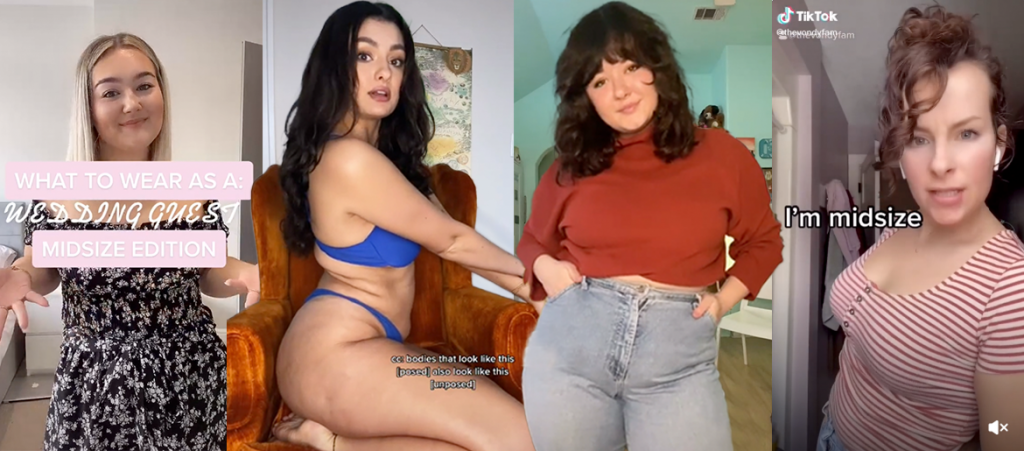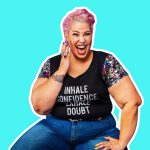
Body positivity (BOPO) has been around in some way, shape or form since forever. The idea behind bopo can pretty much be boiled down to loving the skin you’re in, in a world that tells and sells you the idea that your body is ‘wrong’ – an experience almost everyone can relate to. The emergence of the mid-size bodies trend seems like an extension of the body positivity movement, driven by TikTok posts about styling outfits, trying on swimwear, and fashion hacks for self-described mid-sized women. But in reality, the term ‘mid-size’ isn’t as inclusive as you might think.
Read on to understand how the mid-size bodies ‘trend’ is just another way we uphold society’s bias against fat people.
The origins of the fat liberation movement
First, a quick history lesson. The body positivity you see on social media was actually born out of the fat liberation movement.
The fat liberation movement started in America in 1969 , when an engineer named Bill Fabrey was angry about how his fat wife was treated. He had read an article a couple years earlier by a fat man called Lew Louderbach about the unfair ways fat people were treated, which Fabrey made copies of and handed out to everyone he knew. He went on to establish what it now the world’s longest-running fat rights organisation, the National Association to Advance Fat Acceptance (NAAFA). At a similar time, a group of California feminists were also angry about the treatment of fat people. They formed the Fat Underground, advocating for ‘Fat LIberation’ (in contrast to NAAFA’s mission for ‘fat acceptance’). By 1973 they had released their groundbreaking Fat Manifesto, demanding “equal rights for fat people in all areas of life” and calling out the “reducing” industries (aka diet culture).
Basically, the idea behind fat liberation is rejecting the notion of body positivity and the diet industry, and instead focusing on uplifting and putting all fat bodies front and centre of a movement designed to celebrate and acknowledge fat bodies, not just those that are acceptable to the public eye.
What is mid-sized appreciation, exactly?
It’s not a new concept. What is now classified as mid-sized was once called ‘inbetweenie’ and could be defined as “small fat” on the existing Fatness Spectrum. The classification mostly comes from fashion sizing – with mid-size generally starting at around size AU16 to about AU20, it’s within a range of sizes that you could still enter a store and buy something off the rack.
The term ‘mid-size’ to describe this same category of bodies has gained traction on TikTok, where a younger audience has not had as much exposure to the history of the fat liberation movement and critical body acceptance content.
Success in “fatshion” blogging, and more recently in body positivity influencing or microblogging on social media, has always been dominated by these “acceptable” body types and shapes – inbetweenies, small fat, or mid-size women. Weight is usually held in the boobs or hips and butt, and the most successful personalities are generally white, cishet-appearing and conform to traditional beauty standards.
@waitwhatsorry There’s a lot more here #fatliberation #fatpositive #lgbtq #queer #bopo #midsize
♬ original sound – Sarah
But, what’s the big deal? Aren’t all bodies beautiful?
Of course all bodies are beautiful. All bodies deserve to be appreciated. But trend of claiming the ‘mid-size bodies’ label is rooted in fatphobia.
Look at the use, or rather total avoidance, of the word “fat” from the descriptor. Fat is a word that has been used to belittle, degrade and shame larger bodies, and the reclamation of the word by fat people is a powerful tool in growing the fat acceptance and liberation movements. Using a label like mid-size which sidesteps the word “fat” entirely is watering down a concept that has been fought with literal blood, sweat and tears for decades. It’s a way for people to label themselves as different from skinny bodies, but also avoid labelling themselves as fat in any way, which they still consider a “negative” tag.
There is still size discrimination in society: fat people don’t receive the same level of care that thin people do in the medical industry, and are denied jobs because of the way they look, to give just two examples. The goal of body inclusion movements is to remove the stigma associated with how someone looks (like assumptions about health, intelligence, or happiness). Because popularising a term like mid-size only puts the spotlight on people unlikely to face those struggles, it doesn’t help break down those barriers for bigger bodies. And that’s without even beginning to address to compounded discrimination faced by BIPOC, gender nonconforming and disabled people who are also fat – is far worse.
If the old/new push for mid-size bodies trends and “normalising” bodies of people who face no structural or systemic discrimination, maybe it’s not really inclusive at all?
@gaydhdgoddess am I the only one who sees it this way? or…? #fatphobia #fat #plussizeedition #plussize #thicktok #midsize #bodypositivity #hottake #fatliberation
♬ original sound – Sari Rachel
Where do we go from here?
Movements are born out of a need for societal change. But a lot of the time, they get watered down in order to be marketed and sold to us in acceptable packaging – the mid-size bodies trend seems to be doing this exact thing. By conforming to pre-existing societal expectations of what a “good” plus-sized person looks like, it leaves out so much and seems designed to pit plus-sized people against one another.
Sonya Renee Taylor, of the outstanding spoken word piece, The Body is Not An Apology (and book of the same name) aptly quotes Aboriginal artist and activist Lilla Watson: “If you have come to help me, you are wasting your time. If you have come because your liberation is bound up with mine, then let us work together.”
Translation: This is something we all need to do. Those of us who have the privileges afforded by society need to work to uplift those voices who are marginalised by society – we need to allow those voices to take front and centre stage, to be respected and included in the fight for affecting real change for all bodies. Because this fight affects us all.






